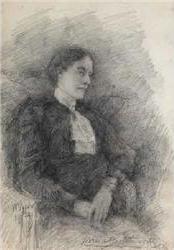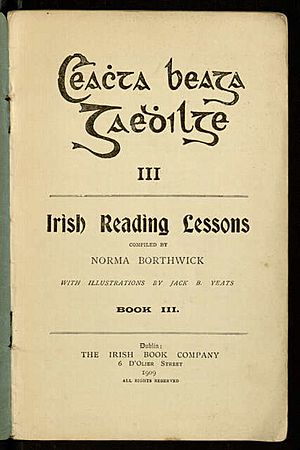Norma Borthwick facts for kids
Quick facts for kids
Norma Borthwick
|
|
|---|---|

Norma Borthwick by John Butler Yeats
|
|
| Born |
Mariella Norma Borthwick
25 July 1862 |
| Died | 13 June 1934 (aged 71) Kilbride, Skye, Scotland
|
| Nationality | British |
| Other names | Aodh Rua, Fear na Móna |
| Occupation | Artist, writer, teacher |
| Known for | Irish-language activist |
Mariella Norma Borthwick (born July 25, 1862 – died June 13, 1934) was a talented British artist and writer. She is best known for her important work as an activist for the Irish language.
Contents
Norma Borthwick: Artist and Irish Language Champion
Her Early Life and Interests
Mariella Norma Borthwick was born in a place called Highfield, near Chester, England, on July 25, 1862. She was one of eight children. Even though she was born in England, Norma felt a strong connection to Scotland. She believed her family came from Gaelic people.
From a young age, Norma was very interested in the culture of Ireland. She even started learning the Irish language at a society in London.
Helping the Irish Language Thrive
Norma Borthwick was a skilled artist. She first became known in Ireland for her drawings. These drawings showed sad scenes of families being forced out of their homes in County Donegal. A newspaper called United Ireland published them in 1890.
She soon became very involved in the movement to save and promote the Irish language. She often visited the west of Ireland and the Aran Islands.
Joining the Gaelic League
In January 1895, Norma joined the Gaelic League in London. This group worked to keep the Irish language alive. She became the treasurer for the London branch.
In 1897, she won a prize for her essay at the first Oireachtas na Gaeilge. This was a big festival for Irish culture and language. Her essay was about "The significance of language to the nationalist cause." She used the secret name "Aodh Rua" (which means Red Hugh). The next year, she won a prize for her singing!
Norma also helped start the Irish Texts Society in London in 1898. This group helped publish old Irish writings.
Leading Roles and Writing
From 1898 to 1899, Norma was a key leader in the Gaelic League. She was a secretary and a member of the main council. People noted her "education and taste" helped the organization a lot.
In 1900, she became the chairman of a new Gaelic League branch in Dublin. After she left the League, there weren't as many strong female voices in the group.
Norma also helped Eoin MacNeill publish An Claidheamh Soluis. This was an important Irish-language newspaper. She wrote a series in Irish for St Patrick's magazine from 1900 to 1903. For these, she used the name "Fear na Móna."
She wrote and drew pictures for her own books too. In 1900, she made Aigibitir na Gaeilge. In 1902, she created a three-book series called Ceachta beaga Gaeilge. Famous artist Jack Butler Yeats drew pictures for these books. (His father, John Butler Yeats, also drew a picture of Norma!)

Publishing and Teaching
Norma Borthwick started the Irish Book Company with a friend, Mairéad Ní Raghallaigh. They published many books and pamphlets. One of their projects was seven booklets of songs called Ceol Sidhe.
Her company also published Father Peadar Ua Laoghaire's famous book, Mo Sgéal Féin. Norma even helped create a dictionary for this book. She later became one of the people in charge of his literary works. In 1913, she worked with Osborn Bergin to publish Leourín na leanav.
Norma was friends with Lady Gregory, a famous writer. Norma stayed at Lady Gregory's house and taught her and other English speakers Irish. Once, she even put on an Irish-language Punch and Judy puppet show with Douglas Hyde, another important Irish language leader!
She also taught Irish at a convent in Dublin and gave private lessons to many wealthy families.
Her Later Years
In 1919, Norma Borthwick left Ireland because her health was getting worse. She moved to live with her sister Grace. They lived in different places, including the Shetland Islands and finally Kilbride, Skye in Scotland.
By the late 1920s, Norma was very ill. She had a condition called "sleeping sickness" after World War I. This illness made her unable to move or speak. She passed away in Kilbride on June 13, 1934. She had been ill for many years. She is buried on the island.

